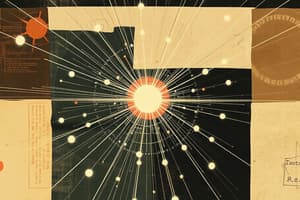Podcast
Questions and Answers
Flashcards
Energy-Frequency Relation
Energy-Frequency Relation
Energy is directly proportional to frequency, defined by E = h x frequency.
Energy-Wavelength Relation
Energy-Wavelength Relation
Energy is inversely proportional to wavelength, defined by E = h x c / wavelength.
Planck's Constant (h)
Planck's Constant (h)
A constant that relates the energy of a photon to its frequency, approximately 6.626 x 10^-34 J⋅s.
Electron Volt (eV)
Electron Volt (eV)
Signup and view all the flashcards
Photoelectric Effect
Photoelectric Effect
Signup and view all the flashcards
Signup and view all the flashcards
Study Notes
- Energy equals Planck's constant multiplied by frequency.
- Energy also equals Planck's constant multiplied by the speed of light, divided by wavelength.
- Planck's constant is provided in exams.
- Electron volt (eV) is the energy gained by an electron traveling through a potential difference of one volt.
- The kinetic energy of an electron accelerating from rest equals e V, which also equals 1/2 m v squared.
- Frequency and energy have a directly proportional relationship.
- Wavelength and energy have an inversely proportional relationship.
- The photoelectric effect occurs when metals absorb electromagnetic radiation and emit photoelectrons from their surface.
- The photoelectric effect is evidence that light is carried in discrete packets.
- Each electron can absorb a single photon.
- Only light frequencies above the threshold frequency will emit photoelectrons.
Studying That Suits You
Use AI to generate personalized quizzes and flashcards to suit your learning preferences.




